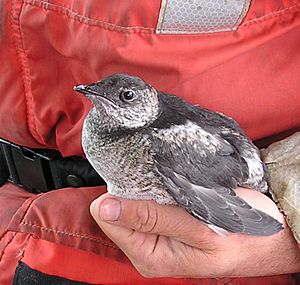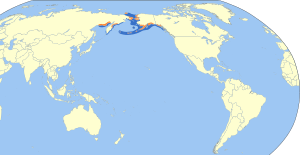Kittlitz's murrelet facts for kids
Quick facts for kids Kittlitz's murrelet |
|
|---|---|
 |
|
| Conservation status | |
| Scientific classification | |
| Genus: |
Brachyramphus
|
| Species: |
brevirostris
|
 |
|
The Kittlitz's murrelet (Brachyramphus brevirostris) is a small seabird that lives in the waters near Alaska and Eastern Siberia. This bird is considered a near threatened species. This means its numbers are getting low, but not as fast as before.
Like its close relative, the marbled murrelet, this bird is special. Most seabirds live in big groups called colonies. But Kittlitz's murrelets nest alone. They build their nests in hidden spots on mountain tops. Native Americans knew about these nests for many years. But scientists called ornithologists only described and photographed them much later.
We don't know a lot about this bird. It is not studied very much. However, people are now more worried about its future. This has led to more research on both the Kittlitz's murrelet and the marbled murrelet. The bird's common name honors a German zoologist named Heinrich von Kittlitz. He was the first person to collect this species.
Contents
What it Looks Like and Where it Lives
The Kittlitz's murrelet is a small, compact auk. It is about 25 cm (10 inches) long. It has tiny legs and special feathers that help it blend in. These feathers are greyish-brown during the breeding season. This color helps it hide on bare ground near snow. In winter, its feathers turn black and white. This is a common look for many seabirds. Its beak is smaller than the marbled murrelet's beak.
Kittlitz's murrelets mostly live and nest in coastal areas of Alaska. You can find them around Prince William Sound and the Kenai Peninsula. They also live along the Aleutian Islands. They nest in Siberia and possibly Wrangel Island too.
How it Behaves and Its Life Cycle
The Kittlitz's murrelet eats close to the shore. It especially likes waters near melting glaciers. It eats tiny fish, krill, and other small ocean creatures. When feeding their chicks, parents bring slightly larger fish in their beaks.
This murrelet is one of the least known auks. We know it does not live in big groups. Instead, it nests high up on mountains, far from the sea. These nests are usually on sunny slopes with bare ground. They are often found near snow.
The female bird lays only one egg. We don't know how long the egg takes to hatch. Chicks are fed all day long. They grow big enough to fly in about 25 days. Their nesting spots are open to the weather. So, chicks keep their soft, downy feathers longer than most other birds. They lose these feathers only 12 hours before they fly.
Scientists think the young birds fly straight to the sea when they are ready. But some also think they might reach the sea by following rivers. After a chick flies, it probably gets no more help from its parents. No young bird has ever been seen with an adult at sea after it has flown.
Threats to the Kittlitz's Murrelet
Before 2014, the Kittlitz's murrelet was thought to be critically endangered. This was based on big drops in their numbers. The International Union for the Conservation of Nature (IUCN) had this status for them.
However, in 2014, the IUCN changed its status. It is now considered near threatened. This is because newer studies show that their numbers are not falling as fast. Some groups of these birds even seem to be stable or growing a little.
The Kittlitz's murrelet faces several dangers. One big threat is global warming. This bird seems to depend on glaciers that are melting. Boats can also disturb them. Oil spills are another danger. For example, the Exxon Valdez oil spill killed about 5-10% of all Kittlitz's murrelets in the world.
See also
 In Spanish: Mérgulo piquicorto para niños
In Spanish: Mérgulo piquicorto para niños


